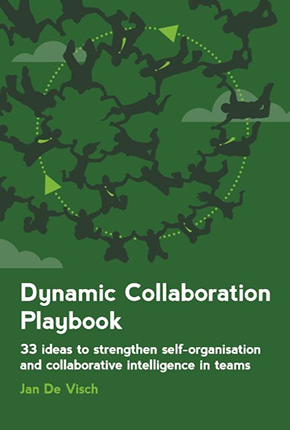Dynamic Collaboration Playbook

Order ‘Dynamic Collaboration Playbook’:
Order combination of ‘Dynamic Collaboration Playbook’ + ‘Dynamic Collaboration’
(1) What is this book about?
This playbook offers 33 practical ideas to help organizations navigate rapid disruption by strengthening self-organization and collaborative intelligence within teams. It moves beyond traditional, behavior-focused approaches, emphasizing the importance of cognitive development and the quality of dialogue. It provides actionable strategies for organizing, creating accountability, making decisions, and fostering better workplaces in a dynamic, interconnected environment. It highlights the importance of “We-Spaces,” different dialogue spaces, and how to create a holistic environment that nurtures quality dialogue.
(2) Who is it written for?
This playbook is designed for leaders, managers, HR professionals, consultants, and anyone involved in organizational development and team management. It’s particularly useful for those seeking practical, actionable strategies to improve team collaboration, self-organization, and overall organizational agility in rapid change.
(3) Why did I write this book?
I wrote this playbook to provide a practical companion to the concepts discussed in “Dynamic Collaboration.” Many organizations struggle to adapt their structures to a rapidly changing environment. This playbook translates the theoretical framework into 33 concrete ideas to stimulate dialogue and support the transition to self-organization, addressing the gap between theoretical understanding and practical implementation.
(4) What makes this book different?
This playbook distinguishes itself by:
- Focusing on Actionable Ideas: It provides 33 concrete, practical ideas that can be immediately implemented.
- Choreographic Implementation Process: The playbook promotes a more dynamic and iterative change aproach, rather than a rigid step by step process.
(5) What has been the added value since its publication in 2020?
Since its publication, this playbook has served as a practical guide for organizations seeking to:
- Improve team collaboration and self-organization.
- Enhance the quality of dialogue within teams.
- Create more agile and adaptive organizational structures.
- Foster a culture of trust and ownership.
- Implement intentional learning and decision cycles.
- Develop a supportive culture of cohesion and coherence.
- Promote collective decision-making and shared ownership.
- Help organizations to understand the developmental stage of the workforce, and it’s impact on collaboration.
The book’s small, attractive pocket size and short, easily digestible chapters have led several clients to give it as a gift to raise awareness among their managers.
(6) You don’t have time to read the book?
If you don’t have time to read the entire playbook, focus on the eight trademarks of a collaborative intelligent organization: Holistic Thinking, Trust Designed in Systems, Ownership Across the Organization, Intentional Learning and Decision Cycles, Supportive Culture of Cohesion and Coherence, Leading the Business as a Commons, Identify Your Developmental Stage, and Choreographic Implementation Process. Then, select a few ideas from each section that resonate with your organization’s specific challenges and priorities. Pay particular attention to the ideas related to “We-Spaces,” dialogue quality, and the integration of adult development concepts. The introduction of the playbook also provides an excellent overview of the core concepts.
Details:
Pocket format (14,5 x 10,5 com), 156 pages, ISBN 798-94-6197-640-6
Price: 20 euro (excl. shipping)
Price PDF-version: 16 euro (the PDF will be mailed to you within 48 hours)
Order the book now. Your copy will be shipped within 5 working days.
Consider the combination package and order ‘Dynamic Collaboration’ together with the ‘Dynamic Collaboration Playbook’:

